Ottoman Coin
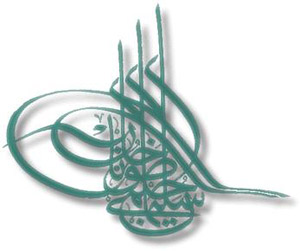 Suppose that you have obtained a coin and there are some writings in Arabic on it. Can this coin be an Ottoman coin? If so, which era is this? You do not know any world in Arabic and there is no nominal value on the coin. I have attempted you how you can perform this recognition in the following writing. First of all a small note: This writing has been prepared only for the coins of the last six sultans. It may not fit completely the ones of previous periods, of which a special permit is required to have it and issued in very different forms. More different than the coins of our age, there is no numbers showing the nominal value of the coin in Ottoman coins and the coins were divided according to their diameters and the weight. There are only two things on the coins of the last six Sultans other than those of which Tunisia and Kashgar mint: on the front side there is tugra and the issuance date at the back. In 80% of 47963 coins that can be found in this book has tugra, only 15% Tunus mint and 1% Kasgar mint there are the name of the sultan and the Issuance date. A) Tugra at the front side 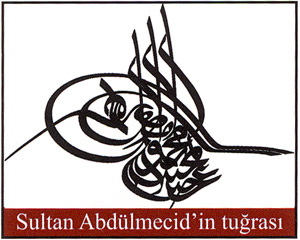
There are two requirements fro proclaiming of being a Sultan, khutba and money issuance in the name of the Sultan. The first thing to be done is to make a tugra in his name. Tugra than can be described as a signature of the Sultan and it was made unique for each Sultan. In a tugra, there are the name of the emperor, name of his father and a prayer : For example, Abdülmecid Han bin Mahmut, el muzaffer daima ( Abdülmecid son of Mahmut, be victorious for ever). Where as the objects like tugra were used in the coins in Ottoman era and subsequent period in the places beyond the boundaries of the country ( Crimea, Sudan, Afghanistan, Indian, Princeshipa, it is very easy to separate them since the details of them had never came close to the delicacy of Ottoman tugra.s if there is a tugra which is made in certain fineness, it is most probably an Ottoman coin. And a last note for tugra, the Turkish name tura ( head / obverse) has been derived from the term tugra. 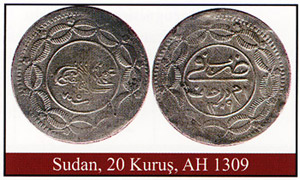
After you have recognized that you have an Ottoman coin, next phase is to determine the era of this coin namely issuance date and the place of issuance. B) Issuance date of the coin Although there is no face value indication on the coins, they all have an issuance date. T here are two different dating system in Ottoman coin Kostantiniye ( Costantinople), Misir (Egypt) and Baghdad, there is the date of the accession of the Sultan:  And at the other side or the same side, it is shown that which year of the reign it was issued. The date of the accession is accepted as the first year and is called as "cülüs" i.e. AH 1255/5 shows the 5th reign year of Sultan Abdülmecid. In order to determine the exact issuance date you can do this simple calculation: 1255+5-1=1259. if you can determine one of the accession dates mentioned above, you can easily find the name of the Sultan. But special care is necessary for the coins issued in 1293, since in this year Abdulaziz was taken from the reign and Murat the 5th era was started, and 3 months later Abdulhamit second reign was started as the third Sultan in a year. These details requiring special care of the coins issued in 1293 have been mentioned in the related pages of these coins. 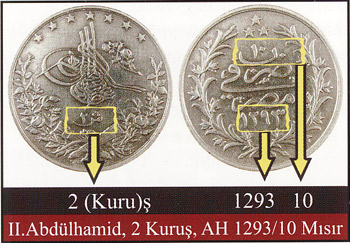 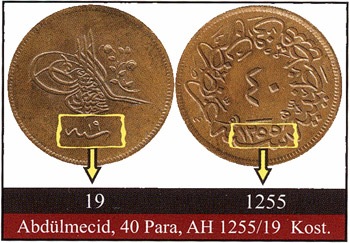 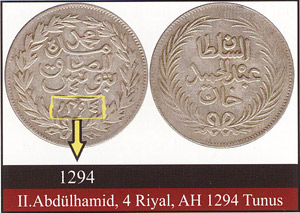
2) Money dated with the issuance date only (e.g. 1266, 1281) In the coins issued in Tunisia, only the date issuance was used instead of the accession date and the year of the reign. For example in Tunisian coins belong to Abdülmecid, you can seethe years from 1256 to 1276. 3) Recognition of the coin A) You can find the four-digit issuance date of the coin which is usually found at the back side using Arabic-Latin number table given below.  B) You have to determine which metal your coin is. And it is not difficult to determine as you can think. Gold: It is a soft metal in bright-yellow color. It doesnot have corrosion and similar things since it reacts chemically too hard. Special care is necessary not to confuse them with jewelry coins named "penez" made of brass alloy similar to golden coins issued by Ottoman State to be used by poor people. Silver: It is brighter than the nickel and in gray color, it has a half matt appearance. Billion: It is an alloy comprising silver alloy less than 50%. It is a metal that can be found in the nature in gray color. Copper: It appears in various brown color according to the ratio and quality of the metal used in coin. It is an easily oxidized metal. Nickel: it is very durable metal hard to be oxidized and in bright gray colos. In order to find the exact issuance date of the money that you have determined the Sultan, diameter, metal and the year. If it is issued in Ksgar or in Tunisia, it is very easy to identify them. Since the exact issuance date has been put on the coin. If it is written as accession date / year of the reign, you have to look at it more carefully. |








